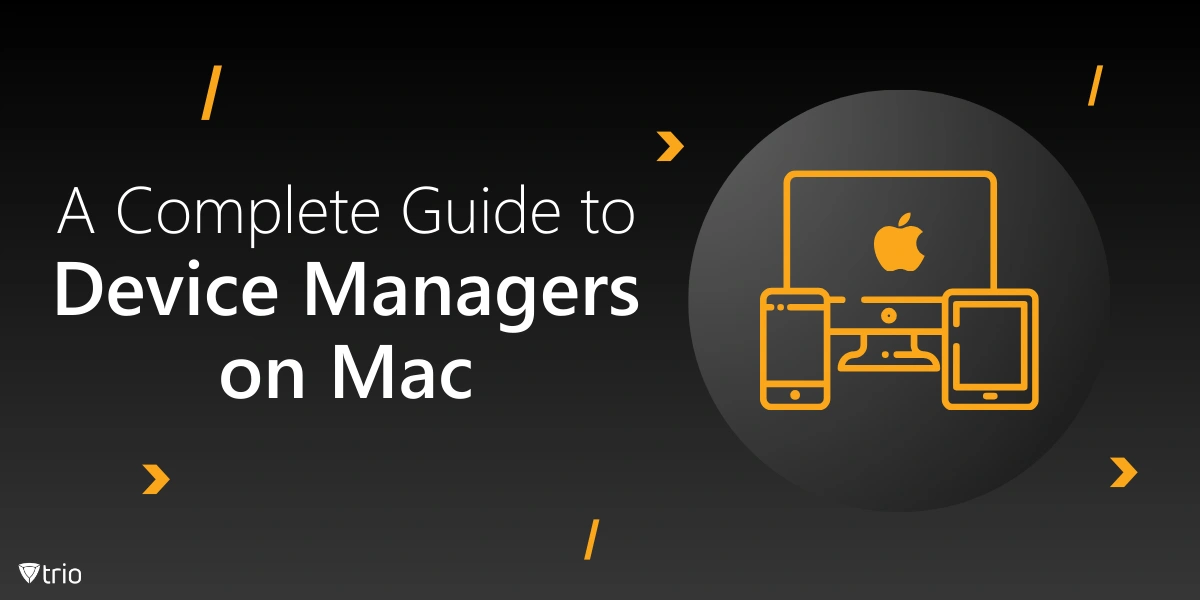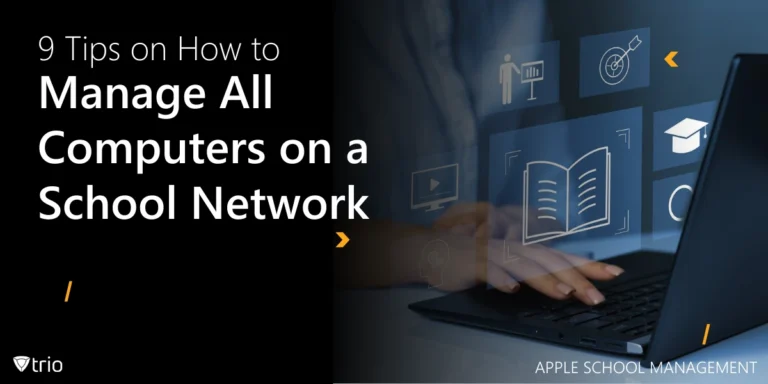With more than 2 billion active Apple devices in the world according to The Verge, effectively managing devices connected to Apple products has become more important than ever, whether you’re a solo Mac user or running a business. Unlike Windows, there isn’t a traditional Mac OS X Device Manager equivalent. However, device management remains crucial for monitoring performance, security, and updates.
For individual users, understanding Mac management helps maintain control over your device’s health and efficiency. For businesses, it’s even more critical to keep a fleet of Macs secure and up to date. This is where solutions like Mobile Device Management Mac (MDM) step in. MDM tools offer advanced features like remote monitoring, automated updates, and policy enforcement.
This guide introduces the tools and techniques available for Device Managers on Mac, helping you decide what works best based on your needs. Whether you’re looking for built-in tools or considering an MDM solution, device management is the first step to ensure smooth and secure operations.
What Is a Device Manager on Mac?
First things first—macOS doesn’t have a traditional “Device Manager” like you might see on a Windows PC. If you’re coming from that world, it’s understandable to expect a similar setup, but macOS handles things differently. Instead of one central hub like the Windows Device Manager, macOS breaks device management into several specialized tools, each offering specific functionality.
One common question is: what is iPhone device management on macOS? Whether you’re managing your Mac device or controlling other Apple hardware like an iPhone, there’s a need for tailored solutions. The macOS device manager ecosystem covers essential tools like “System Information” for hardware details, “Activity Monitor” for system resources, and “System Preferences” for adjusting settings.
However, when managing multiple devices or needing advanced control, tools like MDM for OS X step in. These enterprise-level solutions are essential in environments where security and control over large device fleets are a concern.
Built-in macOS Tools for Device Management
When you need to manage Mac’s connected devices, macOS offers several built-in tools that come in handy without requiring additional software. Each tool serves a unique role in keeping your Mac running smoothly, while also ensuring your device’s security and performance.
First up is System Information. This tool gives you a detailed overview of your hardware and software. If you need to know which Bluetooth version your device has or check your network settings, System Information should be your destination, listing features including storage capacity, installed apps, and even USB connections.
For monitoring performance, you should be looking for Activity Monitor. It shows what’s hogging your CPU, draining memory, or pushing disk usage too high. Utilizing this tool, you can spot apps causing slowdowns and troubleshoot minor issues before they become major headaches.
Then there’s System Preferences, where core settings reside. From adjusting security settings to configuring your user account, you’ll find control over everything from sound and display to network connections here in System Preferences.
For those well-versed in using command-lines, Terminal opens up a world of possibilities. While not for everyone, it offers advanced control over device management, which is perfect for tech-savvy users needing personalized configuration options.
Device Management Challenges
While macOS may work great for individual users, it can be tricky when scaling up to large environments. For macOS management, the built-in tools work well for single devices but hit limits when managing multiple devices across a business. Getting all your devices configured consistently in the process of device lifecycle management can become a headache fast.
One major challenge, as mentioned above, is the lack of centralized control. Unlike traditional systems running on other operating systems, macOS doesn’t provide users with a unified dashboard to oversee everything at once. You’re left handling various tools instead of having a single platform to manage and secure devices.
Security becomes an even bigger concern in these scenarios. Ensuring each device meets the different types of security and compliance standards is necessary but difficult without streamlined oversight. Organizations relying solely on macOS’s default options may struggle to keep every device within policy, creating potential risks that can’t be ignored.

MDM Solutions for Better Device Management
Controlling a few devices with macOS’s built-in tools is manageable, but when scaling up, you’ll need something more extensive. That’s where MDM (Mobile Device Management) comes in. MDM for Mac solutions provide centralized control, allowing IT teams to handle device settings, updates, and security for an entire fleet of Macs effortlessly, especially during the device provisioning process.
Compared to native macOS tools, MDM for OS X brings much-needed remote management features. These solutions automate tasks like policy enforcement, software deployment, and even remotely wiping a device if needed. Whether it’s onboarding new employees with touch deployment or managing device inventory, MDM makes large-scale management far more efficient.
MDM solutions also come with features such as app management, policy compliance, and detailed device monitoring. Even a free MDM iOS option can offer essential capabilities for smaller setups, giving you control over things like app distribution and basic security.
So, when does MDM become essential? If your business is expanding, relies on remote or hybrid work, or requires strict security compliance, MDM solutions offer the automation and comprehensive control needed to keep your Macs secure and well-managed—without the hassle of juggling multiple tools.
Choosing the Right MDM Solution
Selecting the right MDM for Mac can’t be a one-size-fits-all decision. Start by evaluating key factors like ease of use, security features, and integration capabilities. Whether you’re considering a free Apple MDM or a full-scale solution, ensure it fits your organization’s needs.
Scalability matters—your mac management software should be flexible enough to handle both current and future device needs. As your organization grows, your MDM should grow with it and provide seamless support across diverse Apple devices.
User-friendly interfaces and strong customer support are also important criteria to consider. Whether it’s navigating the Apple devices login into MDM or troubleshooting issues, a solution that offers intuitive control and quick assistance keeps everything running smoothly.
Trio is a robust option to consider. Our tools offer an optimal solution that balances all these needs. With an easy-to-use interface, scalable features, and a free demo, Trio ensures your MDM choice is built to handle all aspects of device management.

Additional Tips for Optimum Performance
To keep your Mac running smoothly and extend its life, staying ahead with active maintenance is key. Here are a few practical tips that can enhance your user experience while ensuring your Mac stays in top shape.
- Regular Software Updates: Apple frequently releases updates that improve performance and security, helping you avoid potential vulnerabilities. If your Mac is part of an Apple Business Essentials setup, updates can be easily managed across devices.
- Managing Disk Space: Low disk space slows down performance. Use tools like Disk Utility or third-party apps to clean out unnecessary files. Regularly clearing out junk, cache, and old backups will free up space and maintain speed, especially if you’re frequently installing apps.
- Cleaning Up Startup Items: Too many startup items can cause sluggish boot times. Go to System Preferences > Users & Groups to manage which apps launch at startup. Keeping only essential apps will significantly reduce the load.
- Monitoring Battery Health: Keeping your battery in good shape is crucial. Adjust energy settings and monitor battery health using System Information. If you’re using Managed Apple IDs, centralized battery management becomes even more efficient, particularly for a fleet of devices.
Conclusion
Understanding how to manage MacBook devices and other Apple products is essential whether you’re a solo user or running a business. From built-in tools to advanced MDM solutions, knowing when and how to upgrade your approach is vital to the viability of your business. If you’re managing multiple devices or using a bring your own device strategy, you should assess your needs to find out what works out the best for you.
Whether it’s figuring out what device management for iPhones is better or optimizing your Mac fleet with MDM, effective device management enhances security and efficiency. Taking action now ensures smoother operations and stronger control over your tech environment.
In both personal and business settings, effective device management keeps your devices secure, streamlined, and ready for whatever you need them to do. Don’t wait until issues arise—set up your management strategy today for long-term success.
Get Ahead of the Curve
Every organization today needs a solution to automate time-consuming tasks and strengthen security.
Without the right tools, manual processes drain resources and leave gaps in protection. Trio MDM is designed to solve this problem, automating key tasks, boosting security, and ensuring compliance with ease.
Don't let inefficiencies hold you back. Learn how Trio MDM can revolutionize your IT operations or request a free trial today!




